The UBSS Printed Newsletters
Issues Available Online
2011-2017- 2006-2010
- 2001-2005
- 1996-2000
- 1991-1995
- 1986-1990
- 1981-1985
- 1976-1980
- 1970-1975
- 1966-1969
- 1961-1965
- 1956-1960
- 1951-1955
- 1921-1950
- 1919-1920
The Society produed printed newsletters at random intervals from 1919 to 2017. These have now been superceded by the monthly online version but are still well worth reading.Contents included the latest caving trips, slander/gossip, information on caving in general and the activities of the Society.
Search the newsletter
There is a searchable index of newsletter articles on our Literature Search page.
Extracts from previous newsletters
UBSS Irish Expedition 2013
- Author
- Jacob Podesta
- Photos
- Stu Alldred
The driest summer for seven years and UBSS return to Ireland, hopefully to make up for the wettest summer in 100 years the previous time.
That's how weather works. Due to the varying availability of people, the evening of the 7th of September arrived and a mere four cavers, Stuart Alldred, Anya Keatley, Cameron Bullen and Myself, crossed two countries and one sea to explore, map and describe the caves of Co. Mayo with relatively intact sanities, despite the best efforts of a wayward pair of headphones and Cotton-eyed Joe. Delirious with lack of sleep, the second day was spent making our way from the ferry terminal to our cottage near Ballinrobe. Along the way we went for a walk in Pigeon Hole Woods to scout out the caves there. Had we the foresight to bring a torch, this endeavour might have been more productive. The effects of the day and a half's travel were so acute that we also utterly failed to find the café in Cong with free Wi-Fi, a mistake we didn't make again (twice a day, every day for two weeks).
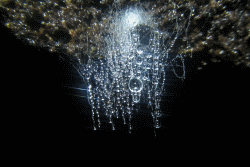
On the beginning of our first fully Irish day, we stocked up the cupboards and returned to Cong to Ashford Castle, where we hoped to find Lady's Buttery and Horse Discovery. After getting verbal permission to survey the caves in the grounds (and, it seemed, do anything we liked anywhere in the local area thanks to an improvised note on a bit of card) from the manager of the hotel there, we got our first bit of Irish surveying done in Lady's Buttery. Whilst I did not know any better, I was assured that "it was much drier than last year". This sentence would be repeated two or three times daily for the whole expedition, usually in a grateful tone of voice.
The following day we set off in the morning to Westport to see if we could find somewhere we could go kayaking to repeat the previous year's antics. Since we were slightly out of season this proved to be a bit of an ordeal, but we were eventually pointed in the direction of the Petersburg Centre, who would prove to be useful contacts later in the week. We organised the kayaking for the day where the most of us could come, which sadly meant that Anya could not. The rest of the day was spent surveying the muddy, wet and spidery Horse Discovery. Since it was a warm day, and we were muddy, we all washed in the sump before leaving presumably to the irritation of the fish that live in the cave.
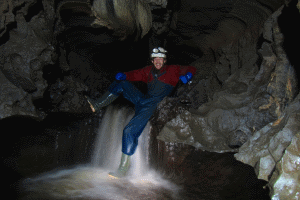
The morning of day 5 was spent filling in the gaps in Lady's Buttery and Horse Discovery after which we set off in search of Pigeon Hole but instead found Wolves' Hole, a cave that was unknown to us at the time. The army had been training in the area and asked us what we were up to. Upon finding out we were cavers, they directed us to Wolves' Hole and wished us luck. Sadly we were ill equipped for the ten metre entrance pitch, so had to save it for after the others arrived with a ladder. When we arrived at Pigeon Hole we discovered we were ill equipped to survey that too, as we had left the PDA in Stu's car. A clammy dash in wetsuits back to the car and a quick cool off in the river later and we finally began surveying. We finished up when the batteries died, sadly rendering the previous 100 splays more or less useless. We made better progress the next day, but found an extension in the back of the cave which more than doubled what we had left to do, right before we picked up Adam from the airport.
The rest of the group arrived the next day but that morning was troubled by bad calibrations and a dwindling supply of batteries, meaning that no actual surveying could actually be done before they arrived. Never mind! It was Cat's birthday so we had to have some kind of party, even if we were all in a different country.
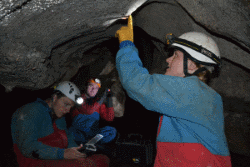
As we left to go kayaking, Anya left for home. After kayaking we asked around the centre, which also runs caving trips, to see if we could get any leads. We were directed to the person who runs these trips who, whilst slightly evasive, did direct us to Church Cave in Ashford Castle. In the afternoon Stu, Cameron, Simon and I continued to explore Pigeon Hole, concluding that there was a lot more than two weeks' worth of work down there, whilst Adam, Rosie and Alice scoured Co. Mayo for lithium ion batteries! Now that we had a ladder and ropes, we could at last explore Wolves' Hole. Adam, Rosie, Simon and Alice spent the day in Pigeon Hole Woods exploring Wolves' and getting coordinates for some other caves in the woods. It turned out that Wolves' Hole is quite extensive, and Stu, Cameron and Simon would spend most of the next three days underground surveying it.
Meanwhile, Cameron, Stu and I took a break from surveying to go for a tourist trip down Allie River Cave, to see what it was like in the drier conditions. On the way back to Cong, Stu rescued some kittens, the hero. In Cong we did some plain cloths caving to survey the microscopic Priest's Cave before revisiting the Guinness tower from last year.
The next three days were spent surveying Wolves' by Stu, Cameron and Simon and searching for leads and information on the surface for the rest of us, the most exciting being the entrance to Church Cave, in the canal under the Church of Ireland.
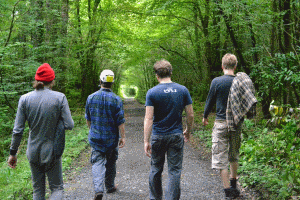
Alice and Rosie left at the end of day 11, and the following morning the rest of us met with the manager of the Petersburg Centre, who we were told has an interest in the caves of the area, to hopefully get some more leads. The chat was very helpful and she seemed very interested in what we were trying to do and we said we would try and contact her again for information next year. After that we drove back into Cong to buy postcards and see if we could get any more information. A chance conversation with a bookseller led to Simon getting some useful information; apparently the bookseller had been compiling all the literature on the caves of the area for quite a while.
To ensure that Adam did not leave Ireland without getting to see the extent of Pigeon Hole, we went on a quick tourist trip there on Adams last day. A small dog attempted to accompany us, but lost its nerve at the last moment and didn't show up for our surveying trip to Teach Aille, a tiny cave which almost immediately sumps. After Adam left, we went on a night time surveying trip to try and link up the entrances of Wolves', Priest's and Pigeon Hole, so that they could all put together on a 3D map of the area.
With two days and four cavers remaining, we went off on a relaxed surveying/photography trip to the short but very pretty Bunnadober and then returned to Cong to say thank you to the lady in the tourist information office, who had been helpful throughout the expedition. After this, we split up and Stu and Cameron finished the Teach Aille survey whilst Simon and I searched for the elusive Lost World Cave. Lost World turned out to appropriately named, as the now collapsed cavern made it a hidden nook in the woods with a sump at either end, and would have made a pretty good spot for a picnic.
The last task for the day was to survey a section of Horse Discovery we had missed the first time. The section was the other side of lake which turned out to be almost exactly six foot three deep. Due to my failure to successfully swim one handed (keeping the DistoX dry at all costs), a pair of wellies now lie stuck in the mud at the bottom of this lake, there for any brave and water competent caver to claim. The extra surveying did reveal a potential lead at the back of the cave however. The cave gods can be generous when provisioned with adequate gifts, it turns out.
Final day and we return to Pigeon Hole Woods for the last time, to survey the entrance of Pigeon and so that I could have a look in Wolves'. We found some workmen erecting a fence around the entrance pitch of Wolves' Hole. Apparently someone had hurt there ankle a few weeks before. Thankfully they were cooperative and gave us a number to organise some kind of access arrangements, making sure we had a tree to rig the ladder off of for the time being. One last trip down Ballymaglancy to clean off our kit and it was back to the cottage to tidy up and pack before we left the following day.
Yorkshire Weekend, Autumn 2004
- Author
- Kayleigh Gilkes
- Photos
- Rob Debois
My first discovery of the weekend: Yorkshire is a long way from Bristol, this seems even longer when entertainment involves making up games to play which involve maths! the number plate game was damn addictive though. The journey got even more exciting when we left the motorway and Frank began navigating, well I say navigating, map reading is probably a better description. He claims it is not the job of the navigator to look at road signs (he couldn't see them anyway due to not having his glasses) and thus I took to shouting random directions at junctions! probably not the best idea but we got there eventually. Arriving at 11.45pm we were glad to discover that Eddy was not lying when he described the Helwith bridge inn as "the best pub in the world". The place doesn't shut and serves good beer and great pork scratchings.
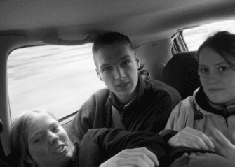
Finally leaving the pub somewhere around 4.30am, we found space on the sofas in the Y.S.S. hut. Unfortunately for Rob, Andy had gone to bed earlier taking his car keys with him, meaning Rob had no sleeping bag.
Time to awaken came all too soon and we were up having breakfast and working out what to do, well what to do during the morning as all the freshers were going S.R.T. training in the afternoon. After much deliberation, we headed to Ingleton to purchase various articles of kit before Eddy, Andy and Emily went caving and the remaining 6 of us tried to establish the best way for 6 people to fit into Superted's car (it's small!). Don't ask me why but for some reason, I volunteered to go in the boot, this turned out to be quite a good move as I had the most room, but may have looked slightly weird (no change there then!).
Arriving back at the hut, there was still time to kill, so Laura, Christian, Frank and I went for a walk and got chased by sheep before returning to the hut in order to catch the minibus which was supposed to be coming to take people to Ingleton for the training. This did not materialise, so we decided to fit even more people and kit into SuperTed's car. There was no room in the boot so I ended up lying across 4 people on the back seat, I feel sorry for the German girl from Southampton who got my feet (although she did crush Frank a bit - last time he says "there is room for a small one").
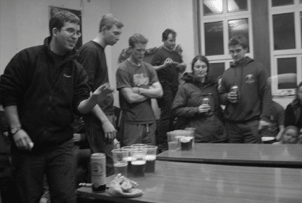
S.R.T. training was great, although I don't think I will ever remember the order the kit goes on in. Thankfully the minibus arrived with the people we had been unable to fit in the car and was there to take us back, meaning I could sit up!! Tonight it seemed had lots of plans. A list of competitions was attached to the wall for people to take part in. The first was beer pong which Christian and I entered substituting cheap vodka for the beer. Beer pong involves 2 teams each with 6 pint glasses set up in a triangle at either end of a table, each containing half a pint (or equivalent drink). The aim is to throw a ping-pong ball into the opposition's glass, thus forcing them to consume the contents, the winning team being the one with drinks remaining. Why York were allowed to enter a tea total team I don't know, surely they had drinkers. We defeated Manchester and Ireland on the way to the semi-finals, using the underarm technique, where we met Kent. The game was very tight with one glass remaining on either side, only for us to be defeated by the hand of... the inflatable woman - she moved the glass at the last minute, my protests were not heard and we were out (not that I'm a bad loser or anything!). Oh well at least I had some vodka left, no mixer though, but we ran out of that in round 2, and Kent lost to Cardiff in the final. I am now known as vodka by cavers around the country (thank you random man from Manchester!). We didn't participate in body traversing, which since having attempted it and been dropped heavily on my back (Cheers Christian! I have bruises), I think is a good thing. A team was entered for the drinking competition, 4 pints drunk from a bucket through tubes by 3 people, step forward Rob, Superted and Christian. We lost badly to Sheffield, much to my anger in my drunken state (Sorry guys, love you really), and Rob and Christian ended up being sick over a wall whilst Frank and I gave advice.
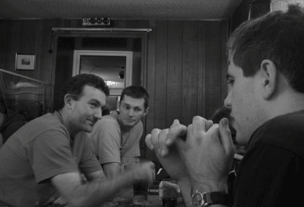
Having finished the vodka, we headed to the pub to find Laura, Emily, Andy and Eddy drinking in a much more civilised manner and thus missed the rest of the competitions. A consequence of this is that I still do not know what body rigging is. It involves 3 people, 10 meters of rope and a murrain (not sure what this is) - any suggestions as to how this may work?
Having gone to and fro from the pub, I finally left when the landlady wanted to go to bed close to 3am and returned to the marquee, to find Rob and Superted, amongst others topless dancing, don't ask me why, I'm not even sure if they know. Once we had danced with all sorts of people the music was finally ceased and we headed off to bed.
Christian, Frank and Laura were the early risers, up at 8am, in order to climb Pen-y-Ghent before breakfast. Eddy too left early for a meeting and the rest of us rose at varying times. Now without anyone in our number who knew the caves of Yorkshire, we sought advice on non-S.R.T. caves and decided to head to Kingsdale in order to go down valley entrance. All but Superted were feeling up to this, but he drove us there anyway. I now had the opportunity to wear my new kit, apparently I look like an overgrown baby in my furry, but then at least my stuff fits, which is more than I can say for Christians borrowed over suit. He had to be helped into it by Superted, only to discover that he had left his chocolate in the pocket of his trousers... this is obviously why the suits lack arses, one of the most humorous scenes of the weekend now occurred, with Superted reaching in through the hole to retrieve said chocolate... there are photos of this.
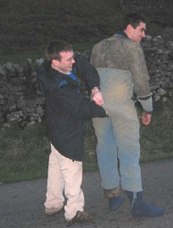
Finally kitted up, we headed into the cave through an oil barrel in the side of the hill. The weekend of new experiences was to continue, with a ladder climb down to the stream, which was successfully accomplished by all. The cave is very wet and great fun as a result, with the water being just strong enough to carry you if you lie in it. As you can imagine, this occupied us for sometime and we floated much of the way back to the ladder - brilliant... even in the dark, when you light has fallen off your helmet and into the water. This incident meant my beam was a bit distorted for the rest of the trip, but all was good. Unfortunately for Emily, her light had been on the way out since we entered the cave, so she spent much of the trip relying on the rest of us for light. A dryer area of the cave allowed Laura to invent an alternative to crawling - the sideways roll - much less painful on the knees and very amusing.
Leaving possible the most fun cave I have yet been in, we returned to the car and were in the process of getting changed when Superted returned. Yorkshire is cold! Saying goodbye to Andy, Emily, Rob and Laura, we headed back to Ingleton to return the lights before beginning our journey home. Due to the amount of stuff badly packed into the car, I ended up crawling out head first over Frank to go into the shop. The journey back was, as far as I know fairly uneventful, but then I was asleep for most of it.
Thank you everybody for a brilliant weekend. I spent way too much money, know some more games and had great fun. Bad luck you haven't scared me off yet!
UBSS Underground In Bristol
- Author
- Steve Cottle
Some of this years special caving trips have been arranged locally. With a number of near-by underground secrets Wednesday evenings were the suited to being the optimum day for these visits. From caving in Southmead in the impressive Pen Park Ho le to a specially arranged trip down Redcliffe mines.

These mines date back to at least the 18th century when the area of Redcliffe became an important area for glass making. There are many possibilities as the original excavation of the mines though dating back through Alfred the Great and eve n to cavemen. The sandstone of the underlying rock was excellent for the manufacture of glass being made for bottles to export water from the Hot wells of Bristol. However as Redcliffe was already built upon and the sandstone had to be mined. The mines sp an over a very large area that cannot be quantified now due to the loss of areas by the building of the harbour railway and bombing from the blitz. However thanks to the ACG a trip was arranged for the mines on one Wednesday in November.
A large number of cavers met at the tacklestore for this trip and despite managing to loose Rachel between there and the caves around about 15 people were kited out with lights etc for the trip. Graham had managed to make a few copies of the available survey which were suitable distributed around so that groups could head off and explore the whole of the known area. I think that most cavers found all the interesting parts of the mine including the wall of the railway tunnel, the shafts that lead up to different levels (now inaccessible due to possible contamination in the war from the hospital above) and the pottery dump. Most of the passage is large walking with rounded arches supporting the roof. A few low crawls lead to some more cramped passages an d the more inaccesible areas that the more organised pre-arranged historic Bristol tours do not visit. For many this was an excellent chance to explore somewhere previously unvisited-visited and for others a chance to see some of the history of Bristol. Roland, equipped with camera at hand was there to record the events for posterity.
Ref: Secret Underground Bristol by Sally Watson.
Access courtsey of Alan Gray
Bonfire weekend
- Author
- Dickon Banks
We arrived shortly before ten at the tackle store and met Taz; in what she told us was a rare on time appearance. About this time I discovered I had left my wellies behind and she kindly gave me a lift to pick them up. After travelling to the hut in style in the smoking car we arrived to find the preparations under way, both the bonfire and fire pit being constructed by Tim with his trusty chainsaw.
Andy, Rachel, Andy and I headed off to G.B. When we got to the blockhouse we found that the key wouldn't open the padlock. During our attempts to open the door, a group from Portsmouth U.S.S. arrived and had a go with a Cerberus key. Combined attempts failed to resolve the situation and then a third group arrived, when their key failed to open the lock as well, it was felt that perhaps we should find a cave where the hardest pitch wasn't getting through the entrance. The Portsmouth group had a slight problem in that their minibus had gone and wasn't going to be back for four hours. Andy volunteered to walk them over the hill back to the hut. On the way back in the car we met Taz's Taxis ferrying John and his retrieved wellies out to Rhino Rift. After a cup of tea, both groups set out for Goatchurch. It was quite odd to go into a cave by steps carved into the rock but all became clear after a brief history lesson. The cave itself was fun and surprisingly social, if a little crowded at times!
When we arrived back at the hut the sheep was roasting away and, having procured a cup of tea and a bite to eat, settled down to that time honoured practice of watching the fire and occasionally adding wood to it. As time progressed and more trips arrived back, so the fire started to run more on aluminium, and it was reported the pub was not only having it's own fireworks party, but was already full! The situation was saved however, by two heroes making a supermarket run to resupply dangerously dwindling stores. The price of abstinence has ever been a taxi service. It was at this time a bargain was struck; 'Shall we go halves on a bottle of vodka?' is an innocuous enough statement the full meaning of which was seen later. A short time later the booze arrived back and the fireworks commenced. About this time the vodka in question was shared, Rob downed his half and handed a bemused Jon the bottle. My next sighting of Rob was him being prevented from being over familiar with a recently lit rocket, shortly after, he was leaning against the hut chatting away, when he developed a pronounced list and then gravity took over. There was a horrible noise as he hit his head on a plate, and it was felt that a trip to hospital was called for. The ambulance was remarkably quick and after a brief struggle with the track removed Rob to Weston hospital. The fireworks resumed, the one-legged guy met his fate and much more beer was drunk.
All in all it was a highly enjoyable weekend rounded off, so I am told, by a pub lunch on the Sunday and after all paramedics only attend the best parties.
County Clare, May 1998
- Author
- Graham Mullan
As will be well-known, a dinner was held at Ballynalackan Castle, near Doolin on May 23rd last to celebrate the fiftieth anniversary of the Society's first trip to Co. Clare. Others will, I hope, write their own accounts of what was a most enjoyable occasion. These few words from me are intended purely to introduce the following narratives. These are drawn from the speech given after the dinner by Johnny Pitts, who very kindly wrote them out after the event so that they could be included here.
On the Sunday morning, after the Dinner, we went caving. Only a couple of people failed to "bottom" the cave, Charlie Self had the excuse that he needed to bring his 4 year old daughter out after only a short distance. Tony Boycott's on ly justification was that he had been "last man standing" at the bar the previous night. And after lunch, those that could still move were taken on an Archaeological Tour of the Burren by the President.
In all a thoroughly enjoyable weekend - and some people are already asking about the next one!
UBSS in Co. Clare
- Author
- Extract from a speech made in Co. Clare by Johnny Pitts
How it all began
In 1946 Bob Bendall and I were in the navy. We were not together but we corresponded. We had read Coleman and Dunnington's paper on Pollnagollum and were familiar with the accounts of the pre-war visits to Co. Clare by Ba ker and by the Yorkshire Ramblers Club. We agreed that when we were de-mobbed we should go there ourselves..
I came out of the navy early in 1947 but Bob, who was in the Pacific, did not come home until later. The UBSS was in a state of change. Opportunities for exploration were few and far between. GB had been explored, surveyed and studied. The only recent discovery by the Society was Rod's Pot, a small and unexciting cave. Rhino Rift was being excavated yet again, every cubic inch of the cave so far excavated by hand. To make matters even worse, the discoveries at Long Wood made by the Stri de brothers while they were at Sidcot school were being treated as their private preserve even after one of them had become the secretary of the Society. This led to factions and quarrels.
Charles Barker, who with Francis Goddard had discovered GB Cave, had returned to an academic post at Bristol from his wartime work on explosives. He also was frustrated by the lack of exploration opportunities and found the atmosphere i n the Society of squabbles and back-biting uncongenial for grown-ups. We decided that we would have a holiday in Ireland. We would go to Mitchelstown and Dunmore to see some caves, then on to the south west for some sightseeing and gluttony and finally up to Lisdoonvarna for more caves. The plan was for the two of us to travel on Charles's motor-bike together with all our kit. We had to make the latter as compact and light as possible. We made a ladder of wire and duralumin tube tailored for the pitch in the Old Cave at Mitchelstown. We spaced the rungs as far apart as we dared in order to reduce the weight and took the minimum amount of rope that we hoped would be enough for tethers. Rope in those days of course was hemp.
All went well until we got to Rosslare. The first problem was that the vital petrol ration coupons, ordered well in advance had not arrived. My recollection is that after the best part of a day spent telephoning Dublin, or more correctl y waiting for telephone connections to come available, we only got as far as Wexford on the first day. The more serious problem was that whilst the bike, with its heavy load, had withstood Welsh roads it was no match for Irish roads. After the third tyre failure we decided that Co. Clare was not for us that year. After visiting Mitchelstown we returned to England.
By the following year, 1948, Bob Bendall had returned from the navy and the three of us decided to renew our attempts to get to Co. Clare. Charles had more time (and money) than us to devote to this trip. He got in touch with Jack Colem an and Norman Dunnington, who were planning to continue their work in Pollnagollum that summer, and arranged to join them at the Irish Arms in Lisdoonvarna, which was their preferred base in Co. Clare. The rest of us joined up with them two weeks later. C harles had given up motor bikes, following a serious accident, and my attempt to acquire some wheels had failed when I discovered why the ancient motor bike I had bought cheaply, was so cheap. Public transport was the order of the day. I stayed at the Iri sh Arms with Charles, and Bob camped at Pollnagollum with Mike Gummer who had joined us. We spent a lot of time in Pollnagollum and thereabouts and did some minor exploration. Bob and Mike had the interesting experience of having a party from the Wiltshir e Caving Club led by Adrian Hopkins camping not far away. It was a mixed party. After they had been there a week a sermon was preached in the church in Lisdoonvarna condemning the sinful behaviour of the people camping at Lismorahaun. Charles and I lost n o opportunity of accusing Bob and Mike of damaging the public reputation of cavers by behaving sinfully in their tent.
Probably the most exciting event was descending Poll Elva. We had taken the light ladder from the previous trip and had made a second one like it. Together we hoped they would bottom the pitch. They did - just. But we sadly underestimat ed the amount of rope needed to tether the ladder. As a result we had no lifeline. We went into Lisdoonvarna but failed to find any where that sold rope. Finally, we bought a couple of clothes lines. Tied together they provided a bit of psychological supp ort, particularly when negotiating the join between the two ladders half way down the pot. We had forgotten about that when we made them. There was a gap of over three feet with no rungs.
Next year, 1949, Bob and I decided that the cave with the most potential was the Coolagh River Cave. It looked as though it was an important part of a complex underground drainage system with a large catchment area. Charles had told us that he had seen a sign advertising food and drinks near Ballinalaken Castle so I wrote to the 'Tea Rooms' at the castle and asked if we could camp anywhere in the vicinity. I had a charming letter back from Maisie O'Callaghan saying she would be delighte d if we camped on the lawn. The letter head showed clearly that this was no tea room but a hotel, possibly a grand one. In our indigent state this was a matter of some concern. However we need not have worried. Six of us, Bob and I together with Joan Ligh t (later my wife), Noel Blackwell, John Nash and Hubert Wright, camped on the lawn up by the castle and the O'Callaghans treated us with the greatest kindness and generosity. They sold us food, provided us with water and gave us turf to light huge fires i n the castle to dry out our caving clothes. On our last day, when we were packing up to leave, one of the maids came up to the lawn to tell us that Maisie wanted to see us down at the hotel. We wondered what heinous offence we had committed, but when we g ot there we were ushered into the dining room and given a meal. Maisie would accept not a penny piece for it.
It is not surprising that on all future visits we stayed inside the hotel, not outside in a tent. Ballinalken Castle Hotel was much the best discovery we made in Co. Clare. Nothing, today, would persuade me to go down any of the caves a gain but I will go back to the hotel whenever I can find an excuse. With Maisie's granddaughter, Marian, looking after the guests upstairs and Marian's husband producing superb food down in the kitchen, this hotel, with its magnificent unspoiled views in every direction, is hard to beat for any cave or karst enthusiast with a taste for the good things in life.
That first year we decided right away that we had to tackle the exploration, survey and study of the cave as Coleman and Dunnington had tackled Pollnagollum, and as Glennie and others were currently tackling Ffynon Ddu. We had to do it systematically and thoroughly. This we did, and it took us three years. Of course we took time off occasionally and looked into various other holes, known and unknown. But we did not let them distract us from the job in hand.
During our last season in the Coolagh River when we were completing the, by then, rather boring task of following the individual beds through the cave, two members of the team, Kay Dixon and I think Noel Blackwell, went off to look at a new area with attractive geology and topography but no known caves. This was the west side of Poulacapple and they discovered the Cullaun series of caves. The cave they entered and partly explored was Cullaun 1, the cave which subsequently earned the nic kname 'The Teenagers Cave'. The reason for this was that this year, 1951, was the first on which some of the older members of the Society came to Co. Clare to see what we were up to. Trat, Bertie and Marjorie Crook, Molly Hall and Frank Frost of the Wesse x Club came to Ballinalaken while we were there. The discovery of Cullaun 1 greatly excited them and they seized it with enthusiasm, taking it over completely. In no time at all Trat was striding through the cave pontificating and producing theories. I th ink it was Molly in her gently mocking way who christened her older companions the 'teenagers' because of their rather juvenile behaviour.
That really established Co. Clare as a major caving area for the Society. Not only had members surveyed and studied a major cave in a way that added substantially to the understanding of the hydrology and spelaeology of the area, but th ey had also discovered a completely new series of extensive caves that were waiting to be explored and studied. Little did they know that, thanks largely to Trat's newly aroused interest in the area, half a century of underground work lay ahead!
The UBSS in the late forties
- Author
- Johnny.K.Pitts, 8th June 1998
From 1945 to 1950 was a time of transition for the Society. People like Francis Goddard and Rod Pearce, medical students who had been successive secretaries during the war, had moved on to adult life and had less and less time for caving. Professor Dobson, who had been President all through the war, died in 1947 and was succeeded by Trat who had been released from internment in Singapore at the end of the war. He continued working in Singapore until 1950 but visited the U K on many occasions during those years and picked up the threads of his long involvement with the Society. Bertie Crook, who as Treasurer had played the role of elder statesman through the war years, progressively handed over that role to Trat. Bertie had served in the First War but was still actively caving during this period. Desmond Donovan returned from the army, becoming the curator of the museum in 1947. New students appeared, like Arthur ApSimon, who half a century on would become President, and Ra lph Stride, who instantly became secretary, and almost as quickly became involved in bitter factional squabbles.
There were some very interesting characters about at this time. Dina Dobson, the widow of the late President was a large lady who swept through the Society like a ship in full sail. She married Martin Hinton, recently retired from the N atural History Museum, and changed her name to Dina Dobson-Hinton. Martin was a dryly humorous man of a sceptical disposition. He jointly edited the proceedings with Dina and appeared at the hut occasionally in her wake. He was a palaeontologist of consid erable distinction and is suspected of having been the perpetrator of the Piltdown Man hoax. I can well believe it.
A dynamic Italian physicist, Beppo Ochiallini, with a nose for important research projects came to work at the Royal Fort with Cecil Powell. He was a caving enthusiast and became involved with Max Cosyns and Marcel Loubens in the explor ation of the Pierre St Martin cave in the Pyrenees. Loubens, of course, was later killed in the 300 metre entrance shaft when he fell off the end of the winch cable. Beppo brought the other two to Bristol and we had a few caving trips with them. I remembe r going down Swildons Hole with them and Trat. It was interesting that Trat, Cosyns and Beppo had one thing in common - they had all been in prison. Cosyns had been in a concentration camp, Beppo had been a political prisoner, and Trat, of course, had bee n interned in Singapore. My clearest memory of that visit was a film show in the geography lecture theatre. Loubens's film of the Pyrenees was shown and we retaliated with the Lamb Leer film. Trat operated the projector but could not get the take-up spool to work. We watched with horror as miles of 16mm film festooned itself all over the theatre.
My dear old friend Charles Barker, still reasonably hale and hearty in his eighties I am delighted to say, brought a great advantage to the Society. When he returned from his wartime work on explosives some of these useful chemicals cam e with him. At that time it was virtually impossible to obtain commercial blasting explosives for amateur use. Charles's souvenirs seemed like manna from heaven. There was a problem however. Military explosives were not ideal for blasting. They were rigid solids that could not be moulded to the surface of the rock to be demolished. Much of the explosive force was dissipated in the inevitable air gap. They had a much higher detonation velocity than gelignite and were very stable. This made them difficult t o set off. A primer explosive had to be used in conjunction with a powerful detonator. This was extremely inconvenient. Charles used to cast the explosives into appropriate shapes after melting them in a saucepan on his mother's gas stove. He then made up appropriate primers and we had to attempt to find bits of rock of the right shape and size to blow up. After numerous disappointing bangs Charles applied his fertile mind to the wartime developments of 'hollow' or 'focused' charges. He cast lumps of TNT RDX with a conical recess on the face that was to come in contact with the rock. They were no more successful than the earlier bangs.
His last hurrah was an experiment to cut down one of Trat's large trees with a cunning device based on this principle. He reasoned that a flexible tube filled with explosive and wrapped twice around the trunk of a tree would create an a nnular space of roughly triangular cross section surrounded on two sides by explosive and on the third side by the tree. This, he assured us, would act as a circumferential hollow charge and cut the tree trunk in two. It did not. It succeeded in turning t hree feet of the lower trunk into a curious flexible structure about which the fifty feet of tree above gyrated in a drunken way without falling over.
By this time commercial blasting explosives had became available. To get a licence however we had to have our explosives store inspected by the police. It was therefore a matter of some urgency that we should dispose of Charles's privat e munitions. We blew them up in the bottom of a blind swallet not far from the hut, with the secondary objective of digging a new bog. To our surprise, a couple with their clothing in some disarray emerged from the bracken close by. The expressions on the ir faces combined astonishment, lust and pride in about equal proportions.
Mud, mud glorious mud; the joys of the G.B. Dig...
- Author
- Andy Farrant
Those of you lucky and privileged enough to have joined the UBSS caving elite and actually gone caving, or at least spent some time in the Red Lion, may have heard rumours, myths and legends about the infamous GB Dig. Much of wha t you may have heard may have not been too complimentary - 'its wet, muddy and horrible...' 'why..?' and 'digging is for the beardy-wierdy old lags'. So, why have members of the club spent the last 25 odd years toiling away (albeit intermittently) in the muddy grovel at the end of Bat Passage? Good question. There are several reasons.
1. You are a masochistic mud-loving social leper with a perverted interest in small dark shitty holes, and you can't find anything better to do on a Saturday night. (I think Hugo probably fits into this category as I can't think why els e he goes digging - it may also explain his penchant for Bos Swallet!).
2. You were told it's really fun and jolly exciting, that fame and fortune await you, or else you were press-ganged/drunk when you agreed to help.
3. You want to find lots of nice big caverns measureless to man, and can't afford lots of expensive expeditions to foreign places. And anyway, finding a few hundred metres of passage on Mendip is far more satisfying than a few kilometre s of huge passage that anyone can walk into in some far off tropical rainforest.
A combination of all three is probably nearest the truth, but there are good reasons to think there is a good chance of entering some large well-decorated cave beyond the current end of Bat Passage. This dig has probably the best potent ial on Mendip, as I'll explain. First, you need to understand a little about the cave and how it functioned in the past (sorry - this is one of my geo-rambles again).
Nearly all the caves on the southern edge of Blackdown occur where streams flowing off the sandstone disappear underground upon reaching the limestone. The water descends steeply down through open vadose (above the water table) passages until it hits the water table and then flows to the resurgence through predominantly phreatic (sub-water-table) undulating passages i.e. sumps. The sump level in Longwood is at 40m O.D., only around 20m above resurgence level. Work by Pete Smart and othe rs suggest only c. 9% of the passage between here and Cheddar is open vadose passage.
At present, the water resurges at the foot of Cheddar Gorge. However, the Gorge has had a complex history and has undergone several phases of active incision by a surface river during cold glacial periods. During each subsequent warm in terglacial phase, a new cave would develop, graded to the lower valley floor level. Thus, above the current active conduit are several tiers of fossil phreatic passages. Detailed work in the swallet caves by several generations of UBSS and other cavers, i ncluding Pete Smart, Tim Atkinson, Dave Drew and Derek Ford, have identified at least 4 of these fossil phreatic levels; at 238, 138, 120 and 90m O.D. In GB, only the upper two have been identified with certainty; at 238m (Devil's Elbow route) and at 138m , the Ladder Dig - Bat Passage conduit. The lower levels almost certainly exist, but as yet, GB has not been pushed deep enough to find them.
Thus, the Ladder Dig - Bat Passage route is a fossil phreatic passage at the 138m level that probably flowed to a former resurgence in Cheddar. So, there is good evidence for a significant amount of fossil passage beyond the dig face. T here is also a fair amount of depth potential before the main streamway reaches sump level. At present, the streamway terminates at the massive choke beneath Great Chamber. However, this choke has already been by-passed at high-level via Bat Passage. Almo st certainly the continuation of Bat Passage beyond the dig will intersect vadose inlets draining into the continuation of the GB streamway, in much the same way as the Devils Elbow stream is a recent vadose inlet connecting the old phreatic passage with the much younger Boulder Chamber. Blue Pencil passage in Swildon's Hole is another example.
So, not only is there potential for old high-level phreatic passages, but the prospect of a link back to the main stream continuation. This may also provide a link into the lower fossil phreatic levels and an associated series of vadose inlets (similar to White Passage and Rhumba Alley). One only has to look at the immensity of the Gorge and Great Chamber to get an idea of the potential size of passage still to be found. In addition, it is possible that the downstream continuation of Ch arterhouse Cave may connect into GB, either at or downstream of the Great Chamber collapse. The diagram below is my prediction of the sort of passage we may find (and not a dowsing rod in sight...).
What about the actual dig? Known to some as the GBH dig, (for causing grievous bodily harm to its diggers), it was started back in the 1960's shortly after the discovery of Bat Passage. A cross section and plan is shown below. At the en d, the large Bat Passage breaks down into a series of two or three parallel paragenetic rifts. Paragenetic cave development occurs when sediment deposition on the floor causes a passage to erode upwards, rather than incise the floor. As a result, these ri fts are almost completely sediment filled. Only the upper rift remained free of sediment. This high level rift leads into a small chamber with two possible leads. However, this was deemed un-diggable due to the abundant pristine formations in the passage immediately before the dig. So, to bypass this, the lower wetter dig was started.
Over the intervening years, many teams have been involved. I began digging in 1989, and eventually broke through into the original end chamber reached in 1966. Although we were hoping to bypass the end chamber, it certainly is not a was te of effort. We can now start digging where the original explorers couldn't without ruining some fantastic formations. At the end, we have two options; either we continue at low level and hope to break up into the open upper level continuation, or we pur sue the upper chamber leads, which may require banging. Hopefully, once we get beyond this sediment filled phreatic loop, the passage will open up again to a passage similar in form to Bat Passage
At present, the dig face will need a few trips to clear the accumulated spoil and to make the entry up into the end chamber easier. The pump may need an overhaul as well. Once that is done, we'll have plenty of digging and stacking spac e, plus no bad air problems. It'll still be a bit squalid getting there, but all the horrible work hopefully has been done.
So, get digging; fame, glory and caverns measureless to man await you...!
New Year Trip to The Lot Valley, France
- Author
- Jon Telling
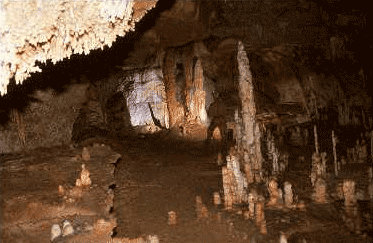
The trip started (too!) early on boxing day morning ; everyone piling on the boat from Dover - Calais, and driving down through France (Steve and Andy in their vans, Simon and me grabbing a lift in Tim's 'not so new as it used to be' Peugeot 206). Journey highlights: Tim managing 110 mph in his supposedly 105 mph max. car (later - in what can only be described as a near-death experience - he managed to force a French driver off the road and up a grass verge!), and a night stop-ov er on the way down in a cheap Fl hotel where a combination of red wine, whisky, 2 bunk-beds and various odd bodily positions (ooh-err) left me with overstretched ligaments in a knee. Not the best start!
The caving itself was pretty spectacular ; Pucelle in particular. A large underground stream running 2.5 km through spectacular limestone formations - Swildon's on a grand-scale. Scrambling and sometimes swimming along, shooting down wa terfalls on your arse, all good fun. Not so fun was losing £300 worth of tackle in a particularly deep plunge-pool ("Do you think it'll float?" "Maybe, if you keep a hand on it. Ahh.") - unfortunately preventing us from reaching the bottom.
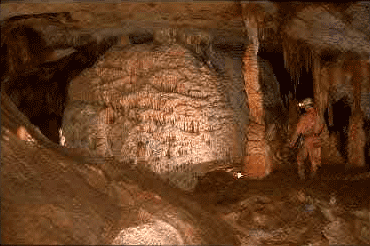
Iges de Pendent was a good SRT trip - 115 m down, lots of be-lays, a splash round in the underground stream, and up again. And the Iges de Sol ; a 60 m initial drop through a vertical shaft into large caverns with huge limestone formations, ending in a small cavern with almost every spot taken up with mud sculptures of various kinds ; some superb, others not, most with large , er, genitalia (saying something about cavers' mentality in general?) by previous artistically-inspired cavers. UBBS now have their own sculpture along similar lines.
New Years eve was similar to the other days (cave during the day, hit the beer/wine in the evening), only more so. Even so, we all managed to go caving on New Year's Day (after fixing the drainpipe on the roof - ask Simon!).
Overall, definitely worth the visit, and I'll make the bottom of Pucelle next time